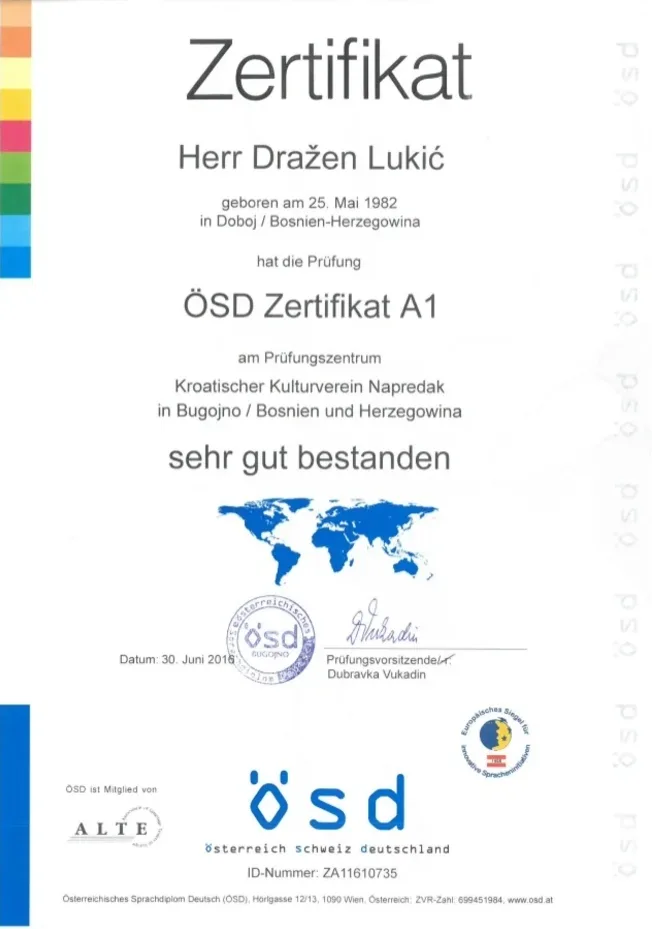We've Had Enough! 15 Things About ÖSD Certificate A1 We're Tired Of Hearing

Understanding sprachzertifikat b1 : What You Need to Know

In an increasingly interconnected world, the ability to interact in several languages has become a valuable property. For people looking to demonstrate their proficiency in the German language, the Austrian Language Diploma (ÖSD) provides a structured and recognized certification program. Amongst the different levels of this accreditation, the ÖSD Certificate A1 functions as the entry point for newbies. This short article looks into the qualifications of the ÖSD A1 certification, its purpose, structure, and significance, together with answers to some regularly asked concerns.
What is the ÖSD Certificate A1?
The ÖSD Certificate A1 is a foundational language efficiency test created to measure a prospect's capability to interact in standard German. It falls under the Common European Framework of Reference for Languages (CEFR), which offers a standardized scale for assessing language proficiency. The A1 level is categorized as the starting phase, where individuals are expected to understand and utilize familiar daily expressions and fundamental phrases targeted at pleasing useful needs.
Value of the ÖSD Certificate A1
The ÖSD Certificate A1 has a number of important ramifications for individuals wanting to boost their language skills and enhance their personal and professional potential customers. Here are a couple of reasons why this certification is considerable:
Structure of Language Learning: The A1 level acts as a stepping stone for learners who wish to advance to higher levels of proficiency in German.
Worldwide Recognition: The ÖSD certificates are widely recognized in Austria and Germany, increasing employability in German-speaking nations and strengthening visa applications.
Evaluation of Basic Skills: The exam evaluates necessary skills in reading, writing, listening, and speaking, offering students a clear understanding of their linguistic ability.
Structured Learning Path: Obtaining the A1 certificate sets the groundwork for students to methodically construct their language skills.
Structure of the ÖSD Certificate A1
The ÖSD Certificate A1 consists of four primary parts that examine various language abilities:
Listening Comprehension (Hörverstehen):.
Candidates listen to taped dialogues and brief texts. They should respond to concerns that assess their understanding and capability to extract important information.
Reading Comprehension (Leseverstehen):.
This segment consists of reading short texts, dialogues, or advertisements, followed by questions that inspect understanding and interpretation.
Written Expression (Schreiben):.
In sprachschule österreich , learners should produce brief composed texts, such as submitting kinds or writing easy messages, demonstrating their capability to interact in composing.
Oral Expression (Sprechen):.
Candidates engage in a conversation with an inspector, which can consist of answering concerns about individual topics, explaining familiar items, or discussing daily circumstances.
Getting ready for the ÖSD Certificate A1.
Success in the ÖSD A1 examination requires appropriate preparation. Here are sprachzertifikat b1 for efficient research study:.
Research Study Materials: Utilize ÖSD-approved books, online courses, and practice tests specifically designed for the A1 level.
Broaden Vocabulary: Focus on vocabulary related to everyday topics such as family, jobs, foods, and hobbies.
Practice Listening: Engage with German-speaking media, consisting of podcasts, films, and songs, to enhance listening abilities.
Discussion Practice: Join language exchange programs or groups to practice speaking with native speakers or fellow learners.
Mock Tests: Regularly complete practice tests to familiarize oneself with the exam format and time restraints.
Advantages of Earning the ÖSD Certificate A1.
Achieving the ÖSD A1 certificate not just confirms one's language skills but likewise unlocks different chances for personal and professional development. Here are some advantages of holding this accreditation:.
Improved Job Opportunities: Many employers in German-speaking countries value language accreditation, especially at the A1 level, as it shows dedication to interaction.
Admission to Language Courses: Some language schools require proof of A1 proficiency as a requirement for advancing to higher courses.
Self-confidence in Communication: The certificate increases self-confidence in basic communication, a vital skill for living or working in a German-speaking environment.
Cultural Immersion: Learning the language invites much deeper cultural understanding, making it possible for people to connect more meaningfully with German-speaking communities.
FAQ Section.
1. Who is eligible to take the ÖSD Certificate A1 exam?
The exam is open to people over the age of 16 who wish to show their fundamental knowledge of German. No previous qualifications are required.
2. What is the passing rating for the ÖSD A1 exam?
Prospects need to accomplish at least 60% of the overall points to pass the evaluation.
3. Where can I take the ÖSD A1 exam?
The ÖSD A1 exam is offered in different assessment centers around the globe, particularly in Austria and Germany. It is recommended to check the ÖSD website for the nearby place.
4. How long is the ÖSD A1 certificate legitimate?
The ÖSD Certificate A1 does not expire, and students can present it anytime to show their efficiency.
5. Can I prepare for the exam on my own?
Yes, lots of candidates effectively prepare independently using study materials, however participating in classes or language workshops can help with quicker discovering.
Conclusion.
The ÖSD Certificate A1 works as a crucial tool for those starting their journey to learn the German language. With its structured method and acknowledgment in German-speaking areas, this accreditation leads the way for boosted interaction skills, enhanced employment potential customers, and a deeper understanding of German culture. By investing time in preparation and practice, students can accomplish this fundamental milestone and set the phase for continued language development.
